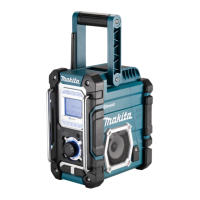
Do you have a question about the Makita DMR108N and is the answer not in the manual?
| Radio type | Portable |
|---|---|
| Tuner type | Digital |
| AM band range | 522 - 1710 kHz |
| FM band range | 87.5 - 108 MHz |
| Auto digital tuning | Yes |
| Supported radio bands | AM, FM |
| Preset stations quantity | 10 |
| RMS rated power | - W |
| Display type | LCD |
| Bluetooth version | 5.0 |
| USB connector type | USB Type-A |
| USB 2.0 ports quantity | 1 |
| Material | ABS, Thermoplastic polyurethane (TPU) |
| Projection | No |
| Antenna type | External |
| MP3 playback | - |
| Product color | Black, Teal |
| Volume control | Rotary |
| Number of alarms | 2 |
| International Protection (IP) code | IP64 |
| Battery voltage | 18 V |
| Power source | AC/Battery |
| Warranty period | 3 year(s) |
| Sustainability certificates | CE, UKCA |
| Package type | Box |
| Depth | 262 mm |
|---|---|
| Width | 163 mm |
| Height | 431 mm |
| Weight | 4300 g |
Identifies and describes the main physical parts of the radio unit, numbered 1-18.
Details the various symbols and information displayed on the LCD screen (A-I).
Symbol indicating the need to refer to the instruction manual.
Symbol for waste electrical and electronic equipment disposal in EU countries.
Essential safety guidelines to follow when using the electric tool.
Comprehensive rules for safe handling, storage, and use of battery cartridges.
Warning regarding potential explosion if batteries are incorrectly replaced.
Advice on maximizing battery life and proper charging procedures.
Instructions for installing backup batteries (UM-3/AA) for memory retention.
Guidance on inserting the main battery pack for powering the radio.
Lists compatible battery cartridge types and their voltage ratings.
Provides estimated operating hours for radio and Bluetooth modes based on battery capacity.
Illustrates symbols for cluster and slide battery types.
Warning against using non-specified battery cartridges to prevent injury or fire.
Detailed steps for installing and removing both slide and cluster battery cartridges.
Explains how to check remaining battery capacity and indicators for replacement.
Guidance on positioning the antenna and connecting the AC power adaptor.
Instructions for powering on/off, selecting AM/FM, and auto-tuning stations.
Steps for manually tuning radio stations and adjusting volume.
How to store and recall up to 5 preset stations for AM and FM bands.
Describes various display options available in FM radio mode, like RDS information.
How to switch between stereo and mono for better reception of weak FM signals.
Procedure to tune into previously stored radio stations using preset buttons.
How to set the clock to display in either 12-hour or 24-hour format.
Steps to select the preferred format for displaying the date.
Manual adjustment of the radio's current time and date settings.
How the radio can automatically synchronize its clock using RDS CT signals.
Detailed steps for setting radio-based alarms with various recurrence options.
Instructions for setting Humane Wake System (HWS) buzzer alarms.
How to stop a sounding alarm by pressing the power or alarm button.
Procedure to disable previously set alarms.
How to activate snooze and adjust its duration when an alarm sounds.
How to set the radio to automatically turn off after a set period.
How to enable or disable the loudness function for enhanced audio.
Instructions for connecting external audio sources via the AUX IN socket.
Steps to pair a Bluetooth device with the radio for music streaming.
How to automatically or manually reconnect previously paired Bluetooth devices.
Important notes on pairing limits, disconnections, and troubleshooting Bluetooth.
Procedure to manually disconnect the paired Bluetooth device from the radio.
Instructions on using the radio's USB port to charge external devices.
Important warnings and notes regarding USB charging and data backup.
Warnings and advice on what to avoid when cleaning or maintaining the radio.
Details on power requirements, adaptor, and compatible battery types.
Information on radio frequency ranges and Bluetooth version, profiles, and range.
Details on loudspeaker, output power, input terminals, and antenna system.
Specifications for the radio's physical size and weight.
